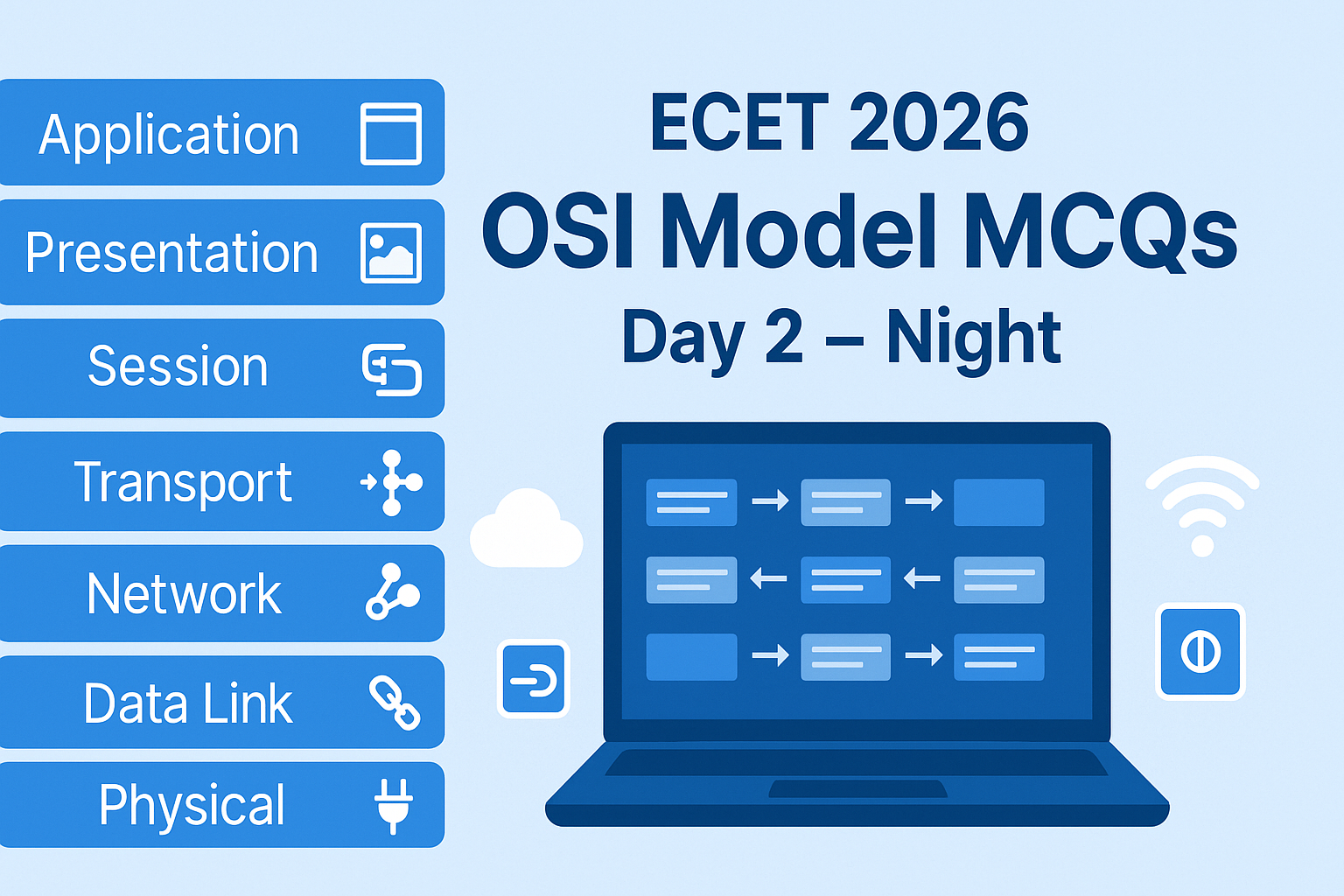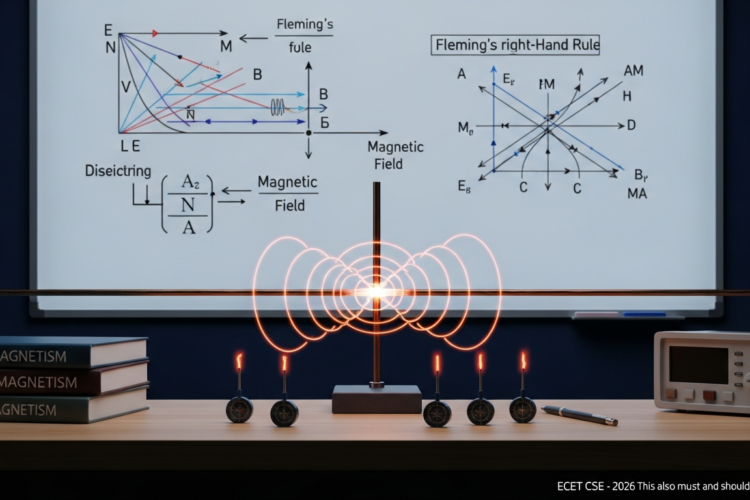
If you’re preparing for ECET 2026 under the C-23 curriculum, then understanding the OSI Model is crucial. This concept frequently appears in Computer Networks sections across APECET and TSECET papers. Knowing how data travels across a network layer by layer not only boosts your fundamentals but also improves your score in multiple-choice questions. Let’s dive into the OSI model—explained clearly and concisely, followed by 10 practice MCQs with answers and solutions.
📘 Concept Notes – OSI Model Explained
The OSI (Open Systems Interconnection) model is a conceptual framework developed by the ISO (International Organization for Standardization). It standardizes the functions of a telecommunication or computing system without regard to its underlying internal structure and technology. The OSI model divides network communication into seven distinct layers, each with a specific function.
🌐 The 7 Layers of the OSI Model (Top to Bottom):
- Application Layer (Layer 7):
- Closest to the user.
- Provides services like email, file transfer, and web browsing.
- Presentation Layer (Layer 6):
- Translates data between the application and network formats.
- Handles encryption, compression.
- Session Layer (Layer 5):
- Manages sessions and controls dialogues between devices.
- Transport Layer (Layer 4):
- Ensures end-to-end communication, error checking, and data flow control.
- Uses TCP/UDP protocols.
- Network Layer (Layer 3):
- Handles logical addressing and routing.
- Uses IP addresses.
- Data Link Layer (Layer 2):
- Responsible for node-to-node data transfer and error correction.
- Includes MAC addressing.
- Physical Layer (Layer 1):
- Transmits raw bits over a physical medium.
- Includes cables, switches, and electrical signals.
💡 Key Points to Remember:
- Mnemonic: “All People Seem To Need Data Processing” (Top to Bottom)
- OSI is a theoretical model; real-world applications use TCP/IP, which maps to OSI.
- Important Protocols: HTTP (Layer 7), SSL (Layer 6), TCP/UDP (Layer 4), IP (Layer 3), Ethernet (Layer 2)
🔟 10 Most Expected MCQs – ECET 2026 [OSI Model]
Q1. Which layer of the OSI model provides email services?
A) Presentation
B) Transport
C) Application
D) Session
Q2. In the OSI model, encryption is typically done at which layer?
A) Network
B) Presentation
C) Application
D) Session
Q3. Which layer ensures error-free delivery of data?
A) Transport
B) Data Link
C) Network
D) Session
Q4. What is the function of the Physical Layer?
A) Routing
B) Frame detection
C) Bit transmission
D) IP addressing
Q5. MAC addressing occurs in which OSI layer?
A) Application
B) Network
C) Data Link
D) Transport
Q6. Which OSI layer deals with logical addressing?
A) Data Link
B) Physical
C) Network
D) Transport
Q7. Which layer is responsible for data compression?
A) Application
B) Presentation
C) Network
D) Transport
Q8. TCP and UDP protocols operate at which OSI layer?
A) Network
B) Application
C) Transport
D) Session
Q9. The layer that initiates communication and establishes sessions is:
A) Network
B) Session
C) Presentation
D) Data Link
Q10. In which layer are HTTP and FTP protocols used?
A) Session
B) Application
C) Transport
D) Network
✅ Answer Key Table
| Q.No | Answer |
|---|---|
| Q1 | C |
| Q2 | B |
| Q3 | A |
| Q4 | C |
| Q5 | C |
| Q6 | C |
| Q7 | B |
| Q8 | C |
| Q9 | B |
| Q10 | B |
🧠 Explanations of All Answers
- Q1 → C: Application Layer supports services like email, file transfer, etc.
- Q2 → B: Presentation Layer handles data encryption and decryption.
- Q3 → A: Transport Layer ensures error detection and recovery.
- Q4 → C: Physical Layer is responsible for raw bit-level data transmission.
- Q5 → C: MAC addresses work at the Data Link Layer.
- Q6 → C: Network Layer manages logical IP addressing and routing.
- Q7 → B: Presentation Layer compresses data to improve transmission.
- Q8 → C: TCP and UDP are core transport protocols.
- Q9 → B: Session Layer creates, manages, and terminates sessions.
- Q10 → B: HTTP, FTP, SMTP are Application Layer protocols.
🎯 Why This Practice Matters for ECET 2026
The OSI model is one of the most frequently tested topics in ECET’s Computer Networks section. Mastering these layers helps you identify real-world protocols, decode network-related questions easily, and secure 1–2 marks with confidence. By practicing structured MCQs with explanations, you’ll also build exam speed and conceptual clarity—two essentials for scoring high in CSE stream exams.
📲 Join Our ECET Prep Community on Telegram
Want daily ECET-focused MCQs, PDF notes, and video sessions?
Join our Telegram group: 👉 @LearnNewThingsHub
Stay ahead with the best revision tools and group discussions.



